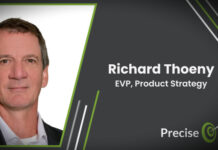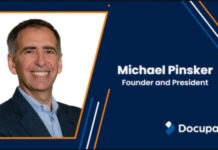Data entry has become so simple in most areas of daily life, it’s an afterthought for the consumer.
Most websites and apps can now be logged into with a click confirming one’s identity via Google or a social media network, exposing consumers to a range of services with simplicity and immediacy.
Yet, at the same time, the financial services industry is “painfully far behind” in providing these kinds of experiences to consumers, said Richard Thoeny, executive vice president of PreciseFP product strategy at Docupace.
“I would say the financial services space is pretty far behind in a lot of ways just in the adoption of technology,” said Thoeny. “There’s a whole bunch of reasons for that, it has to do with the data that has to be shared across platforms a lot of times. It’s not just difficult to get the data, it’s difficult to have a single-source of truth for that data, plus the data is in disparate formats.”
Different systems have different structures of data, said Thoeny. For example, one system may look at data segmented by accounts, while other systems may segment data on the client or household level.
What the industry needs, then, is a platform that helps advisors and firms gather accurate client data efficiently, and then shares that data with all of the pieces of an advisor’s technology stack.
Why Data Gathering Matters
“Everybody has to gather this data, but almost no one does it very well,” said Thoeny. “Of course, the main reason is that it’s not easy to do. Everyone has different methods and formats for doing it. In this case, simple is hard: creating a simple way to do this effectively and efficiently is very hard to do, so people haven’t solved for it.”
Data gathering shouldn’t just be efficient, it needs to be accurate, said Thoeny, so that advisors don’t have to ask clients multiple times for the same pieces of information, and so that it doesn’t need to be re-entered and corrected repeatedly.
If data is collected only once, it creates a more streamlined, simple and modern experience for clients, said Thoeny, and allows the advisor to project an air of competence and trust. Data should be gathered in an engaging manner that is bound by rules and validations, then recorded and reported correctly and accurately.
“Accuracy is more efficient, it places less stress on the people in your organization,” said Thoeny. “There’s no finger-pointing down stream because the data is just there, available and easy to update. They can push it, move it around and use it, because it’s all normalized data that can be sent to these other systems.”
Why Are Advisors So Far Behind?
But old habits die hard, said Thoeny. Advisors aren’t getting any younger, and many are accustomed to legacy platforms and processes—the old way of doing things—and since they have used tried-and-true methods for a very long time, they are reluctant to change.
For example, Thoeny was presenting at a conference on behalf of PreciseFP, a data-gathering and data-sharing platform offered by Docupace, along side a very senior provider who used a paper form for data gathering.
“This was a very progressive advisor who created their own simple data-gathering form, and he presented that at the conference—and people wanted it!” said Thoeny. “They thought it was great and amazing, and it was just a form that they would still have had to extract the data from—they thought it was revolutionary, a new, impactful way to think about data gathering.”
And that’s where many advisors are—data gathering is still among the most manual of processes, often conducted using plain paper and pen or pencil—but according to Thoeny, there’s a better way.
What Is PreciseFP
“PreciseFP is a data-gathering platform,” said Thoeny. “It goes well beyond that, but data-gathering is at the meat of it. It’s a way to interact on the front end with a prospect, or to go out and gather data about whatever it is that you want to do. It can be a risk questionnaire. It can be a financial planning questionnaire. It can be used to follow-up on webinars or other client engagements. There’s an unlimited amount of digital fact-finders that you can create and send with PreciseFP.”
PreciseFP, very simply, creates data-gathering tools and opportunities for advisors, said Thoeny. It comes pre-loaded with templates, fact-finding questionnaires, but can also be customized to allow for a range of client interactions.
But under the surface, PreciseFP is also a data-distribution hub, said Thoeny.
Once data is gathered, you can send it to other platforms,” he said. “We permit bi-directional data movement with an advisor’s other systems, primarily the CRM since that is where most client data is stored. So you can send the data PreciseFP collects to CRMs, and you can also pull data out of CRMs to use or to resend to clients for updating and validation. So it’s both a data-gathering platform and a solution for sharing data across systems.”
Why Digitize Data Entry
Digitizing data entry solves for errors like typos and transposition—powering data-sharing eliminates additional opportunities for error by eliminating the need to re-key data.
“If you’re not integrated and feeding data into other systems, someone has to grab it and enter it,” said Thoeny. “We’ve allowed data entry to remain manual, super slow and time-consuming. It’s frustrating for staff to have to go out and re-key and recollect data. Of course, it also doesn’t scale. You can’t scale all of those manual processes—because you can only do one thing at a time.”
It also helps advisors stay abreast of compliance demands, said Thoeny. A lot of regulatory scrutiny has been around advisors’ ability to know their clients and safely keep accurate client information. Without accurate information, an advisor is at risk of running afoul of fiduciary regulations. If poor data gathering leads to an inaccurate record of a client’s income or risk tolerance, which then leads to the advisor recommending inappropriate strategies or unsuitable investments, their firm may be liable.
Think about Regulation Best Interest, and knowing what is in the best interest of your client,” he said. “If you have bad data on your clients, how can you know what is in their best interest? What if your bad data means you have their annual income wrong, or their risk tolerance wrong? Making good decisions on their behalf is predicated on having good data.”
To learn more about how Docupace can help your firm, click here to schedule a discovery session.








